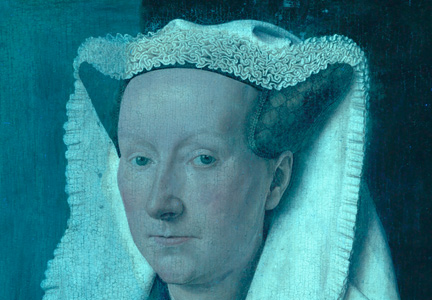
Aged natural resin varnishes based on dammar or mastic can be dissolved by solvents and removed from the surface of a painting on small swabs of soft cotton wool.
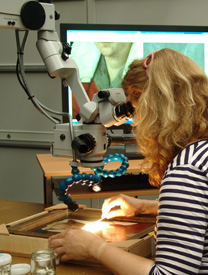
In the case of Margaret van Eyck, this procedure was carried out under high magnification with the aid of a stereo binocular microscope. On a computer screen, the restorer was able to refer constantly to photographs of the painting taken before cleaning and also to useful images such as X-radiographs and infrared reflectograms.
Sometimes old retouchings over losses and areas of damage become insoluble to normal cleaning solvents and have to be removed with a scalpel – a slow and painstaking process carried out under the microscope.
Fortunately most of the previous restoration on the portrait had been carried out using a varnish medium and could be dissolved off with the discoloured varnish layers. This included the grey toning over the white veil and a dark chocolate brown paint which had been applied over much of the black background in order to disguise the chipped and eroded edges to some of the cracks.
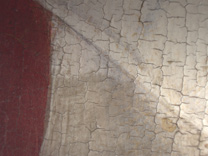
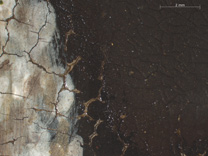
As the removal of the discoloured varnish and the old restorations proceeded, the well preserved original paint surface was gradually revealed. Evidently the painting has been treated with care in the past.
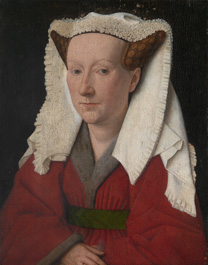
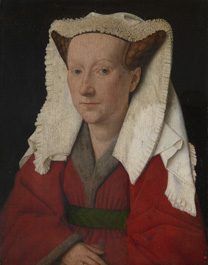
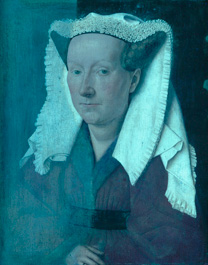
Ultraviolet examination
Indeed, it is possible that some of Van Eyck’s original surface coating has survived. When cleaning a painting, the restorer will regularly evaluate progress by examining the surface with an ultraviolet light source. If necessary, the cleaning can also be documented with an ultraviolet fluorescence photograph.
The technique is useful because natural resins and oils exhibit strong and characteristic types of fluorescence under ultraviolet, whereas the paint layers, which contain pigment, are generally less fluorescent.
The 19th-century varnish still present on the left side of the portrait has the strong greenish-yellow fluorescence typical of an aged natural resin such as dammar or mastic. In the area that has been cleaned, this fluorescence is no longer visible (apart from some small patches at the edges). Over Margaret’s face, headdress and much of her red dress there is still a thin fluorescent layer, but of a more orange-yellow colour.
In the lower right corner, however, an area of the dress appears dark and without fluorescence. In a paint sample from a loss in this area, it can be seen that there is a thin layer of an unpigmented fluorescent substance sandwiched between the penultimate and final layers of red lake glaze.


It seems possible therefore that Van Eyck applied a layer of varnish to the painting when it was almost complete in order to saturate the colours but then decided to apply a further glaze layer over the varnish in the lower right corner to deepen the colour of the folds.1 This glaze remained glossy and saturated and so did not need to be varnished again.
The slightly orange colour of the fluorescence is characteristic of a varnish containing a resin dissolved in a drying oil, as would have been used in the 15th century. The layer may therefore consist of the same heat-bodied linseed oil with pine resin found in the more substantial surface coating on the marbled reverse.2
